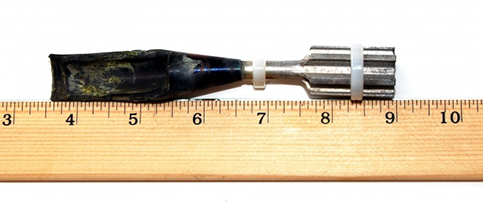Understanding Depleted Uranium Exposure


M101 spotting round showing depleted uranium in black. Photo Credit: By Sgt. Angela Gilmore, U.S. Army, Pacific Public Affairs Office
You may have heard about “depleted uranium,” and while you probably are aware that uranium has some radioactivity associated with it, you probably do not know what it means to have the word “depleted” in front of it.
The process of manufacturing enriched uranium used in nuclear reactors or weapons starts with natural uranium found in the earth’s crust and involves removing some of the radioactivity from the natural uranium to concentrate it for the ‘enriched’ product. What remains of the natural uranium is called "depleted" uranium (DU). DU has 60 percent of the radioactivity of natural uranium (hence, the word “depleted”), and since it is a heavy metal, it has the same chemical toxicity as natural uranium.
Because of DU’s density, easy availability, and relatively low cost, the U.S. military found it to be useful in manufacturing tank armor and some bullets to penetrate enemy armored vehicles. The large-scale use of DU for this purpose began during the Gulf War.
While DU that enters the body can become a potential health hazard because of its radiation properties, the potential for long-term risks from its chemical toxicity are also of concern. Veterans who may have been exposed to DU include those who were on, in, or near vehicles hit with “friendly fire.” When a projectile made with DU penetrates a vehicle, small pieces of DU can scatter and become embedded in muscle and soft tissue. Also, these service members may have inhaled or swallowed small airborne DU particles. Other Veterans who may have been exposed to DU were near burning vehicles, near fires involving DU munitions, or involved in salvaging damaged vehicles. Simply riding in a vehicle with DU weapons or DU shielding will not expose a service member to significant amounts of DU or external radiation. Veterans may have been exposed to DU during the first Gulf War, Operation Enduring Freedom (OEF), Operation Iraqi Freedom (OIF), or Operation New Dawn (OND), or deployment to Bosnia.
VA has been conducting a surveillance program for Gulf War Veterans exposed to DU through “friendly fire” incidents for more than 25 years. Some Veterans enrolled in this program have ongoing DU exposure resulting from DU fragments embedded in their bodies. It is important to note that, to date, no health effects related to DU exposure have been found. Nevertheless, the potential for long-term effects remains, and this group continues to be under surveillance.
VA also maintains a registry for Veterans who are concerned about possible DU exposure during their service. If you think you were exposed to DU and would like to enroll in this registry, talk to your local Environmental Health Coordinator. You will be asked to submit a urine sample and to fill out an exposure questionnaire to screen for DU exposure. Learn more about DU and VA’s DU Follow-up Program.




















